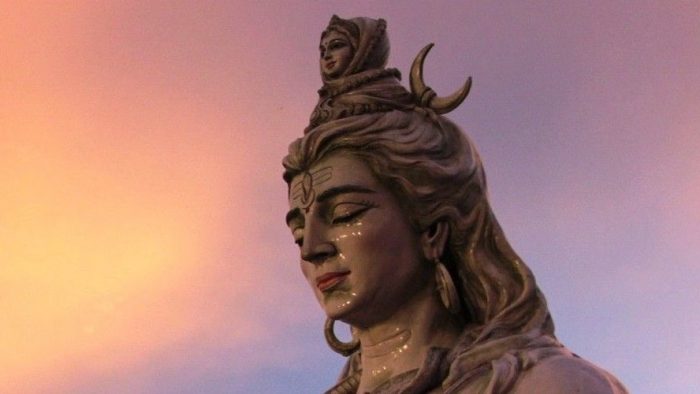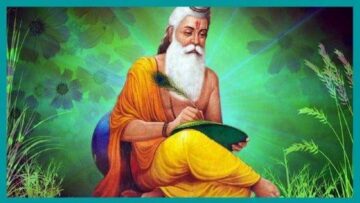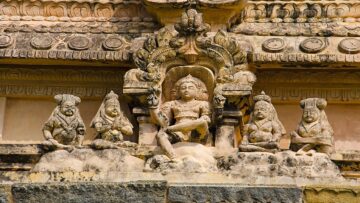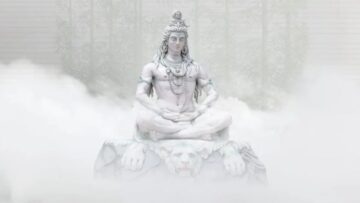The Śaivasiddhānta that developed in Tamilnadu from the 13th century is mainly based on the single most important and shortest ever philosophical text, Civañāṉapōtam in Tamil, composed by the saint Meykaṇṭār in circa 13th century of the CE. As a parallel development there are also quite a few commentaries in Sanskrit composed during the same period.
The Civañāṉapōtam describes the relation between Śiva and the individual self as non-different (ananya).
In the Civañāṉacittiyār, the earliest available commentary on the Civañāṉapōtam, the liberated self is said to experience the śivānanda continuously.
The Pratyabhijñā school of Śaivism though called Trika—a system with three real entities—is actually a pure monism where the only reality is Paramaśiva. The individual self is Śiva Himself contracted by the Māyā which is considered His Śakti while the perceived manifoldness is nothing but the ābhāsa-s of Śiva manifested by His Śakti. Therefore it Trika in the sense of one in three or three in one.
The present paper will attempt to highlight how the Śaivasiddhānta interprets (understands?) advaita contrasting it with how the Pratyabhijñā school makes the three ‘realities’ as one.
The Śaivasiddhānta that developed in Tamilnadu, which can be conveniently called its second phase, (for its first phase see below) is mainly based on the single most important and shortest ever philosophical text, Civañāṉapōtam in Tamil composed by the saint Meykaṇṭār in circa 13 th century of CE, and a series of commentaries on it and sub-commentaries that are widely known as the mainstream Śaivasiddhānta in Tamilnadu and are much studied by the followers. The literature that came after in successive centuries is witness to the progress of philosophical ideas with elaboration, assimilation of new ideas from other systems of philosophy (such as the Advaita Vedānta) and precision.
In the Civañāṉacittiyār the same view is further developed and the liberated self is said to experience the śivānanda continuously. Maṟaiñāṉacampantar interprets the actual meaning of the concept of ‘experience of śivānanda’ (śivānandānubhava) in a different way. He says that the liberated self experiences only its own supreme bliss which was till then covered by the āṇavamala during the transmigratory existence.
Another Śaiva ācārya by name Śivāgrayogī (16th CE) says that since both Śiva and the jīva are all-pervasive (vibhu) the relation between them can only be “aupaśleṣika”. The example he gives for such a relation is that of milk and ghee and that between fruit and its taste.
According to the different commentaries on the Civañāṉapōtam:
- the ontological viewpoint of Advaita is fully refuted.
- There can not be any sort of nondual relation with regard to Śiva and themselves. We can boldly say that this phase of Śaivasiddhānta is completely innocent of any such nonduality.
- Redefines Advaita
The earliest Śaivasiddhānta ācārya-s such as Sadyojyoti, Bhaṭṭa Nārāyaṇakaṇṭha, his son Bhaṭṭa Rāmakaṇṭha who lived in Kashmir from 7th century CE to 9th century and then Aghoraśiva in Tamilnadu in the 12th century held a fully dualistic view according to which, the individual self, even in the liberated state remains separate from Śiva but possess complete similarity with Him in all respects. While Śiva is ever-liberated and never sullied by the impurities (mala-s) the individual selves are also ‘Śiva-s’ but were liberated from the mala-s by the grace of Śiva.1In this there is absolutely no question of any nondual relation.
Though such texts as Ñāṉāmirtam (12th century) that attempt to give the essence of the śaivāgama-s, Meymmoḻicaritai, Tiruveṟivilakkam composed slightly later are known which treat briefly the Śaivasiddhānta doctrines independent of Civañāṉapōtam it was the latter and its commentaries that are widely known as the mainstream Śaivasiddhānta in Tamilnadu and are much studied by the followers.
Generally in these texts the question of relationship between Śiva and the material world on the one hand and the same between Śiva and the individual self on the other are given much attention. The second verse of the Civañāṉapōtam describes the non-different relation (ananyatva) between Śiva and the material world. In the same way, the eighth verse mentions the same relationship between Śiva and the liberated self. The later commentators discuss this ‘ananyatva’ very elaborately.
In the Civañāṉacittiyār, the available earliest commentary on the Civañāṉapōtam, the same view is further developed and the liberated self is said to experience the śivānanda continuously2. In fact this is one of the points of departure and also one of the defining characteristics of the Śaivasiddhānta of the Tamil country (Śivajñānabodha school). Maṟaiñāṉacampantar is the first to devote his attention to the actual meaning of this concept of ‘experience ofśivānanda’ (śivānandānubhava). He says that the liberated self experiences only its own supreme bliss which was till then covered by the āṇavamala during the transmigratory existence. He strongly argues that it is impossible for any person to experience the bliss of another and as such śivānanda can not at all be experienced by the liberated self which is against logic and reasoning. In order to establish his viewpoint he introduces a relation which he calls “ādyantarahitasamavāya”: a relation of inherence without beginning or end. As an example he cites the relation that exists between Śiva and His Śakti3 which he calls “aikyam”.4
Another Śaiva ācārya Śivāgrayogī (16th CE) says that since both Śiva and the jīva are all-pervasive (vibhu) the relation between them can only be “aupaśleṣika”. The example he gives for such a relation is that of milk and ghee and that between fruit and its taste5. He also holds that the liberated self exists so non-different from Śiva that it is Śiva Himself6 and experiences supreme bliss (paramānanda). Arguing further, he says that in the liberated state the self exists as non-different7 from Śiva whose unlimited power of knowledge and action were covered by the āṇavamala in the transmigratory state just as pure water merges with the salty water of the ocean without any separate existence.8 Sivāgrayogī calls this state sāyujya – union with – Śiva.
Civañāṉacuvāmikal of the 18 th century adds further refinement to the same concept. Feeling that to remain non-different from Śiva by losing its identity may lead to the view of Śivādvaita, he firmly establishes that though remaining identical with Śiva, the liberated self certainly enjoys the bliss of Śiva. In other words Śiva is an object of knowledge and enjoyment for the self9. This, probably, is the final view on the Śaivasiddhānta concept of mukti and the relation between Śiva and the self.
Civañāṉacuvāmikal also undertakes to put in order the concept of Advaita. According to him, the negative particle in the word Advaita must denote one of the three meanings: uniqueness which means that the substance exists as only one and there is no second entity. This sense has been taken by the Advaita Vedānta system according to which there exists none apart from the supreme Brahma which does not possess any quality. Because of this they are called kevalādvaita. The same sense is also accepted with slight variation by others such as Rāmānuja, Śrīkaṇṭha who argue that since the upaniṣad-s also speak about the realities such as the individual self and the inert matter along with the highest reality, Brahma, it is wrong to hold that there exists none other than Brahma. So accordingly, Advaita should be interpreted as Brahma qualified along with the other two realities is non-dual which view is called Viśiṣṭādvaita. The dualists though holding on to this sense also accept the existence of other entities which in no way disturbs the nonduality of brahma.
Civañāṉacuvāmikal continues that neither the interpretation of Advaita Vedānta system nor that offered by the dualists is correct as they are against the scriptures. Though the interpretation offered by the Viśiṣṭādvaita is not incorrect it is wrong to interpret Advaita in the sense of one, unity. Therefore, in a nutshell, Advaita should be interpreted as the special relationship between the individual self and Brahma, the supreme Self, namely, Śiva propounded by the Vedic passages. It should explain how the individual self becomes brahma, namely, Śiva.
Civañāṉacuvāmikal elaborates this view accompanied by suitable examples and one may say that it is the final interpretation of Advaita by the Śaivasiddhānta system as far as one knows. Now once the Adavita is interpreted as a special relationship then it has to be analysed and made clear which Civañāṉacuvāmikal undertakes further.
- Advaita may either be complete merger (aikya) just as the river water merges completely with sea loosing its identity altogether or, it can be a merger of the type where the space covered by a pot with the external one when the pot is removed. This type of aikya can not be attributed to Śiva and the self because it would then mean that in the state of mukti there is only one entity which could not be the purport of the word Advaita. Moreover as the self is considered to be merging with Śiva completely abandoning its identity that view is untenable and goes against śruti.
- The special relationship cannot also be a sort of identity (tādātmya) like that exists between a quality and the possessor thereof. For, the self cannot be a quality of Śiva.
- Any other type of relation such as the inherence (samavāya) conceived by the Nyāya system is also untenable by the same argument.
- The Advaita cannot also mean existing together just as two fingers join together. For, since both Śiva and the self are held to be all-pervasive such a relation of joining together or existing together is impossible.
- The interpretation offered by the Advaita Vedānta that such a relation is impossible to be explained (anirvacanīya) cannot be entertained as it is not an explanation at all.
What Civañāṉacuvāmikal finally explains is that tādātmya-relation is of two kinds: that between a quality and the qualified where the difference between them is more pronounced and the other one where two objects existing separately have mutual common attributes that their unity is more perceived. The one subscribed by the śaivasiddhānta system is the latter kind. To drive home this point clear, Civañāṉacuvāmikal cites the passage from the Civañāṉapōtam of Meykaṇṭār which states:
attuvitameṉṉuñ collē yaṉṉiya nāttiyai yuṇarttu māyiṭṭu .10
“Advaita is that which negates the separate existence of two [entities]”.
Still explaining further, Civañāṉacuvāmikal states that this Advaita relation is different from aikya or tādātmya which mainly consists in the difference–cum-non-difference and conjunction (saṃyoga) consisting of duality but a relation which incorporates all these and goes beyond them. The second sūtram of Civañāṉapōtam states that Śiva exists in such a nondual relation with the selves that He is inseparable (oṉṟāy), is separate (vēṟāy) and in and out with it (uṭaṉāy); the Civañāṉapōtam explains it in three ways through examples: In other words, the advaita relation between Śiva and the individual selves —as conceived and explained by the Śaivasiddhānta system is:
Negation in the word advaita can be interpreted as
1. Absence: brilliance and its absence, darkness
2. Opposition: dharma and its opposite adharma
3. Nonduality: That which has no equal, similar object.
By stating Śiva is non-dual it is not meant that Śiva considers Himself to be One. Since there is none equal or superior to Him it is unnecessary and He need not consider Himself so. It is not in usage that the negative particle prefixed before a word does not refer to the absence or the opposite of it. It is but logical that the word advaita denotes two entities which does not differ in their fundamental nature.
To put it precisely, Śiva exists in the relation of oneness, separate and as the in-dweller with the selves.
This is further explained in the Civañāṉapōtam : The sense organs which are inert know their respective objects only when they are instigated by the self; in the same way the self, in its turn, knows them only through the instigation by Śiva. This explains that Śiva, existing as the ‘inner most self’ of the selves ‘acts’/’instigates’ in each and every action of the individual self. The example for this is the case of the sunlight and the light of the stars: These stars get their light from sun but in daytime they do not appear separately; but, because of this , they do not also completely merge with the sun. This view is perhaps is found only in the Civañāṉapōtam , one of the fundamental texts of Śaivasiddhānta system elaborated in Tamilnadu.
Advaita in the Pratyabhijnā School (Trika System)
The Pratyabhijñā system postulates a type of Advaita based on the affirmation of existence of everything within the one; while Śaṃkara attempted to present Advaita by negating the existence of everything other than Brahman based on the Upaniṣadic passage ‘neti neti’, the Pratyabhijñā integrates the multiplicity with the supreme unique Reality which is saṃvid. Unlike the Mahāyāna Buddhists and Śaṃkara, the Pratyabhijñā school of Śaivism is a realist one as it admits the existence of both the immutable supreme reality and its becoming ‘many’ as the phenomenal world. Thus the scope of Advaita is made all-inclusive and all-embracing. The One and the many—the absolute (anuttara) and the universal (viśvātmaka)—constitute the fullness nature of the supreme Reality, the saṃvid.
Further, the supreme Reality endowed with unlimited power (Śakti) that is inalienable from His nature, exercises His power of freedom and manifests Himself out of His own volition (svecchayā) as the world of multiplicity.
As the Pratyabhijñāhadaya puts it succinctly, svecchayā svabhittau viśvamunmīlayati |
As He is Real in its full sense so also His self-manifestation as the phenomenal multitude is equally real. Thus He is both transcendent as well as immanent. One may thus call this Advaita as Integral Philosophy of Non-dualism (akhaṇḍādvaita) as it is based on the affirmation of everything within the supreme Reality.
According to the Īśvarapratyabhijñākārikā of Utpalācārya, the omniscience of the supreme Reality Śiva does not consist in objectively knowing everything that exists independently of and separately from it, but in freedom to manifest and to unite the so as to give rise to all that is necessary for the rise of knowledge. It is omniscient because all phenomena of knowledge emerge from and merge back into it exactly as the dream does from and back into the dreaming individual.
This view is called ‘ābhāsavāda’—by which is meant that only the supreme conscious Reality manifests everything—both its existence as well as its absence—outside by its power and it is supreme Śiva who shines as all these manifestations. Therefore, the objects do not have a separate existence outside Śiva or apart from Śiva, their only source. The external world is not a mere conjecture of the individual self but it is the external manifestation of the unlimited power of Śiva.11 As a corollary, as the supreme Śiva is real so also the manifestation of this multiplicity through His unlimited power is equally real.
Manifestation of cosmos as per the Pratyabhijñā system is called “Descent” – which means descent of cosmic self (Parmashiva) to a limited self (Jiva). It explains the cosmic evolution through 36 elements (tattvas) which include 23 elements of Vedanta without modification, 2 with modification, and prescribes 11 more elements (tattvas).
Conclusion
In the Civañāṉapōtam the concept of Advaita has been completely reinterpreted. The view of non-duality meaning only one held by the Advaita Vedānta is refuted; the view of bhedābheda incorporating both difference and non-difference is also refuted as illogical. It is also not the relation of conjunction (saṃyoga) as conceived by the dualists. The ‘advaita’ interpreted by the text of Civañāṉapōtam belonging to Śaivasiddhānta is the relation of Śiva with the self where He is one with them on the basis of the common nature between them; He is different from them as Śiva is the supreme cause and performer of the five acts of creation, etc.; Śiva is at the same time is the inner most indweller of the selves existing through and through instigating them at their every act.
Thus we have briefly seen how the concept of Advaita (non-duality) as held by the Advaita Vedānta system was refuted vehemently in the development of Śaivasiddhānta and the same Advaita concept was reinterpreted and redefined logically and incorporated into the Śivajñānabodha school that fully developed in Tamilnadu.
We also briefly noted the basic tenets of the Advaita Śaiva Philosophy of Kashmir widely known as Pratyabhijñā and Trika where the phenomenal multiplicity is explained as the free manifestation/emenation of Śiva’s unlimited power and which owe their very existence to Śiva, the ultimate source.
References
1. muktātmāno’pi śivāḥ kintvete tatprasādato muktāḥ । Tattvaprakāśa of king Bhoja, v. 6ab.
2. māyamelām nīṅki araṉ malaraṭik kīḻ iruppaṉ māṟāta civānupavam maruvik koṇṭē (Civañāṉacittiyār, v. 310)
3. Śivajñānabodhopanyāsa, a commentary by Nigamajñānadeśika on Śivajñānabodha, 10. Cf. also Aikkiyaviyal, 10.
4. For further discussions on this point one may refer to T. GANESAN, 2009: Śivajñānabodhopanyāsa, an unpublished commentary by Nigamajñānadeśika (alias Maṟaiñāṉatēcikar, the chief disciple of Maṟaiñāṉacampantar) on the Śivajñānabodha critically edited with copious notes and introduction and translation in English, Published by the Rashtriya Sanskrit Samsthan New Delhi, 2009.
5. See his maõipravàla commentary on øivaàr, såtra 2, verse 1.
6. CivaneŸippirakàcam, 208.
7. CivaneŸippirakàcam, 162
8. ibid. 208. Also cf. ãùadbhedasaho’bheda … guõaguõinoþ prakà÷à÷rayayoþ iva và ananyatvaü prakçte vivakùitam | (Saügrahabhàùya on the øivaj¤ànabodha, 8)
9. Ciṟṟurai on the Civañāṉapōtam, cūttiram 6.
10. Civañāṉapōtam, cūttiram 2, ētu (Reasoning)
11. Abhinavagupta in Tantrasāra, 3:6
Disclaimer: The opinions expressed in this article belong to the author. Indic Today is neither responsible nor liable for the accuracy, completeness, suitability, or validity of any information in the article.










